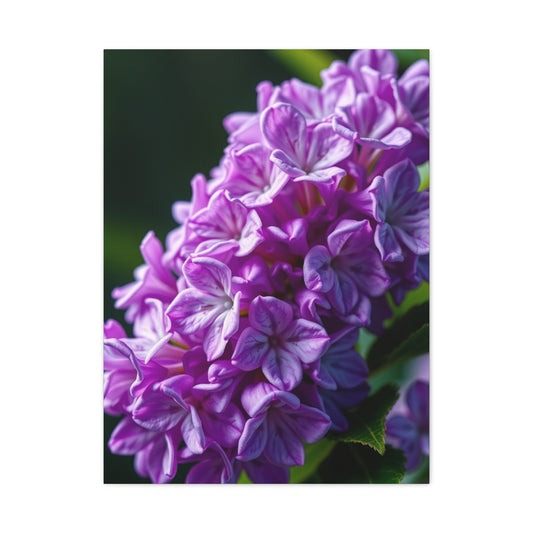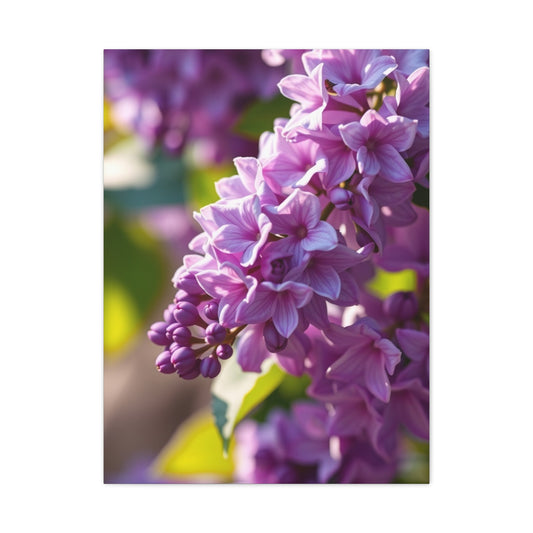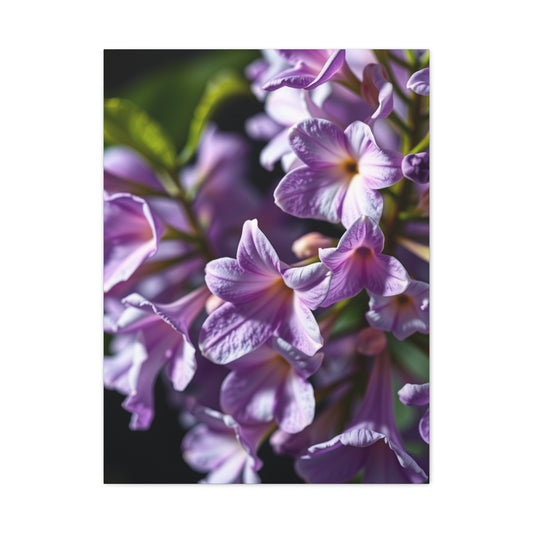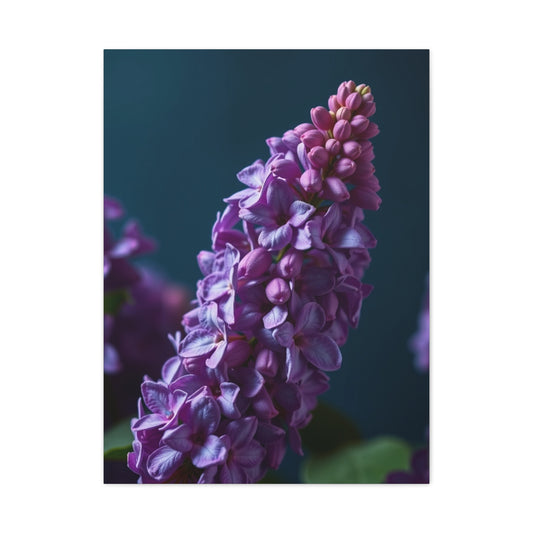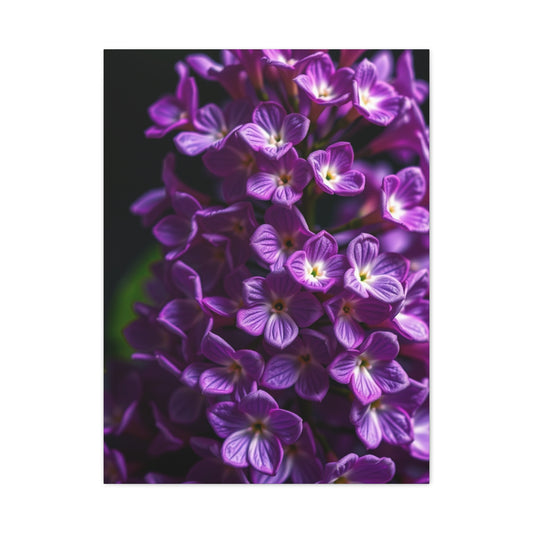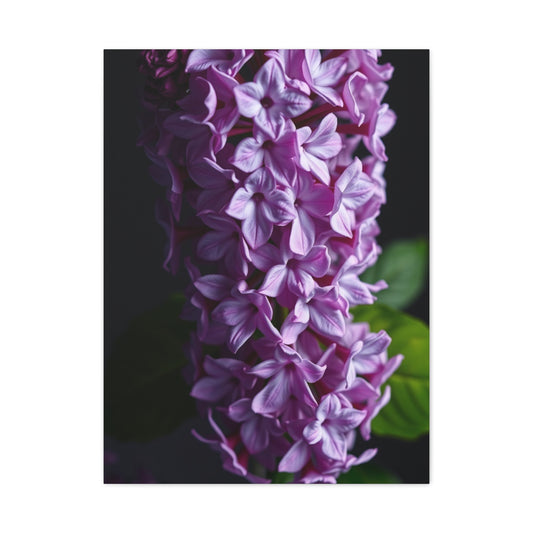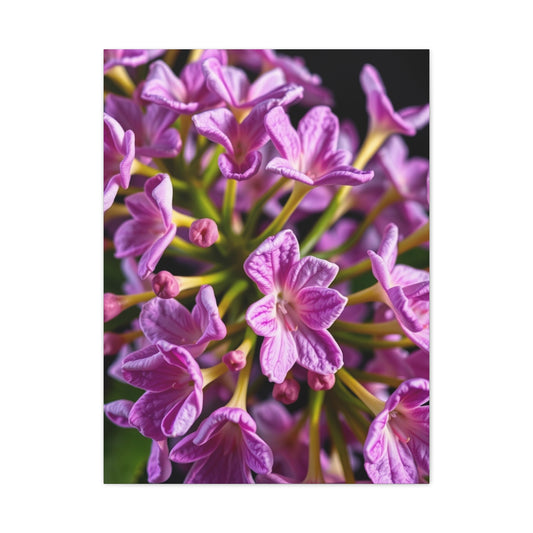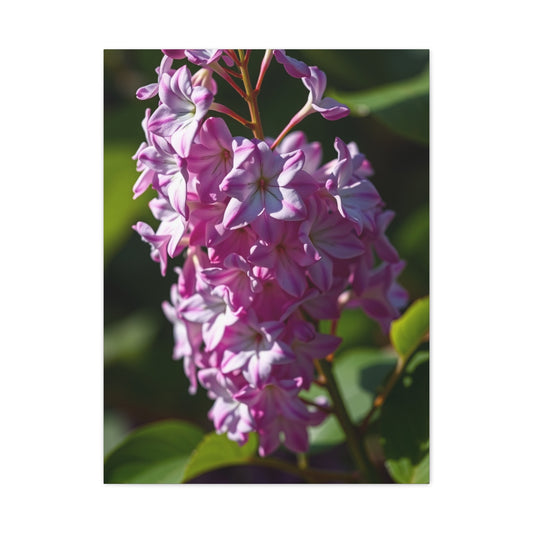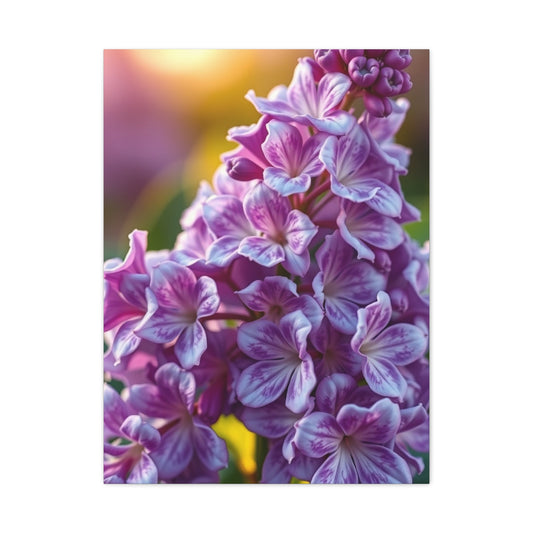Lilac flower Wall Art – A Touch of Floral Grace
Lilac flower wall art brings a gentle elegance and timeless beauty to any space. Known for their soft purple hues and sweet fragrance, lilacs have long been associated with spring, renewal, and emotional depth. When captured in art, these delicate blossoms offer more than just visual appeal—they embody grace, serenity, and romantic nostalgia. Whether you’re decorating a bedroom, living room, hallway, or office, lilac flower wall art adds a refined floral touch that’s both calming and uplifting.
What makes lilac flower art so special is its ability to convey mood through color and form. The lilac’s signature shades—ranging from soft lavender to deep violet—are naturally soothing. These tones evoke feelings of tranquility and femininity, making them a popular choice in wellness spaces, cozy reading nooks, and intimate interiors. In color psychology, lilac and lavender are known to promote relaxation, emotional balance, and introspection, which makes them perfect for spaces where calm and clarity are welcome.
Artistically, lilacs offer great versatility. Realistic botanical illustrations celebrate the flower’s natural detail—clusters of tiny blossoms, textured green leaves, and arching stems. These works are often favored in traditional or vintage-inspired decor. On the other hand, abstract or modern interpretations of lilacs—using watercolor washes, minimal line art, or textured acrylics—can bring a contemporary flair while still honoring the flower’s soft charm. No matter the style, lilac wall art often feels timeless and romantic, bridging the gap between classic and modern aesthetics.
Beyond aesthetics, lilacs carry rich symbolism. In Victorian flower language, lilacs represented first love and youthful innocence. In spiritual contexts, they’ve symbolized renewal and the soul’s awakening. By displaying lilac art, one can subtly infuse a space with deeper emotional or spiritual meaning, creating not just a beautiful environment, but a meaningful one.
Placement also plays a role in maximizing the impact of lilac flower wall art. In a bedroom, a soft lilac canvas above the bed can set a dreamy, peaceful tone. In a hallway or entrance, it offers a graceful welcome. Paired with neutral walls, wooden accents, and light fabrics, lilac art acts as a gentle centerpiece, adding color without overwhelming the room. When grouped with other floral prints or in a gallery wall format, it brings a layered botanical story to life.
How Flower Art Transforms Your Space
The transformative power of flower art lies in its ability to instantly shift the energy and atmosphere of any room. Unlike other decorative elements that might take time to appreciate, floral art creates an immediate emotional response, evoking feelings of joy, tranquility, and connection to the natural world. This instantaneous impact makes it one of the most effective tools for interior transformation.
Color psychology plays a crucial role in how flower art transforms spaces. Warm-toned floral pieces featuring reds, oranges, and yellows can energize a room and make it feel more welcoming and social. These pieces work particularly well in dining rooms and kitchens, where gathering and conversation are priorities. Conversely, cool-toned pieces with blues, purples, and greens create a calming effect, making them ideal for bedrooms and meditation spaces.
The scale of flower art dramatically affects its transformative power. A single large-scale floral piece can serve as a focal point that anchors an entire room's design scheme. It draws the eye immediately upon entering the space and sets the tone for the entire area. Multiple smaller pieces can create rhythm and movement throughout a space, guiding the viewer's eye around the room and creating a sense of cohesiveness.
Flower art also transforms spaces by introducing organic shapes and natural patterns into environments that might otherwise feel rigid or sterile. The flowing curves of petals and stems soften hard lines in architecture and furniture, creating a more harmonious and comfortable atmosphere. This is particularly valuable in modern homes with clean lines and minimal ornamentation.
The symbolic associations of different flowers can transform the emotional resonance of a space. Roses might make a bedroom feel more romantic, while sunflowers can bring a sense of optimism to a home office. Understanding these associations allows homeowners to intentionally craft the psychological atmosphere of their spaces.
Lighting plays a crucial role in how flower art transforms a space. Proper illumination can make colors more vibrant and create depth and dimension in the artwork. Gallery lighting or strategically placed accent lights can turn flower art into dramatic focal points during evening hours.
Top Floral Art Styles for Your Walls
The world of floral art encompasses numerous styles, each offering unique aesthetic qualities and emotional resonances. Understanding these different approaches helps in selecting pieces that align with personal taste and interior design goals. Contemporary realism stands as one of the most popular styles, featuring highly detailed, photorealistic depictions of flowers that celebrate the intricate beauty of natural forms.
Impressionistic floral art captures the essence and mood of flowers rather than their precise details. This style, inspired by masters like Monet and Renoir, uses loose brushstrokes and vibrant colors to create pieces that feel alive with movement and light. Impressionistic floral art works particularly well in spaces where you want to create a sense of lightness and joy.
Abstract floral art takes the colors, shapes, and energy of flowers and interprets them in non-representational ways. These pieces might use flower-inspired color palettes and organic forms without depicting actual blooms. This style works excellently in modern and contemporary interiors, offering the emotional benefits of floral imagery while maintaining sophistication and avoiding literal representation.
Botanical illustration represents a more scientific and detailed approach to floral art. These pieces often feature precise depictions of plants with careful attention to botanical accuracy. Vintage botanical prints have become particularly popular, offering a classical elegance that works well in traditional and transitional interiors. The educational aspect of these pieces adds intellectual interest to their aesthetic appeal.
Pop art interpretations of flowers bring bold colors and graphic sensibilities to floral subjects. Think of Andy Warhol's famous flower prints, which transform natural subjects through artificial color schemes and repetitive patterning. This style works well in eclectic and contemporary interiors where bold statements are welcome.
Minimalist floral art strips away excess detail to focus on essential forms and colors. These pieces might feature single blooms against stark backgrounds or simplified silhouettes that capture the essence of flowers without complexity. This style aligns perfectly with modern minimalist interiors and Scandinavian design aesthetics.
Brighten Your Home with Flower Wall Art
Flower wall art serves as one of the most effective methods for introducing brightness and vitality into interior spaces. The inherent association between flowers and sunshine, growth, and renewal makes floral artwork a natural choice for homeowners seeking to create more uplifting and energetic environments. The strategic placement of flower art can literally and figuratively brighten dark corners, dull hallways, and uninspiring rooms.
Color selection plays a fundamental role in using flower art to brighten spaces. Warm yellows found in sunflowers, daffodils, and marigolds can instantly make a room feel more cheerful and welcoming. These golden tones reflect light effectively and create the psychological impression of sunshine even in spaces with limited natural light. Orange blooms like poppies and marigolds add energy and enthusiasm, while pink flowers such as peonies and cherry blossoms introduce a soft, optimistic glow.
The psychological impact of bright floral art extends beyond mere color perception. Studies in environmental psychology have demonstrated that exposure to bright, nature-inspired imagery can improve mood, increase energy levels, and even enhance cognitive performance. This makes bright flower wall art an excellent choice for home offices, study areas, and creative spaces where mental acuity and positive energy are desired.
Placement strategies for brightening effects involve considering natural light patterns and room function. Positioning bright floral art opposite windows can help reflect and distribute natural light throughout a space. In rooms with northern exposure or limited windows, warm-toned flower art can compensate for the lack of natural warmth and create a sense of perpetual spring.
The size and quantity of bright floral pieces also influence their brightening effect. A single large, vibrant floral piece can serve as a sunshine substitute in a dark room, while a collection of smaller bright pieces can create points of light throughout a space, similar to how actual flowers dot a garden landscape.
Seasonal considerations add another dimension to brightening with flower art. Rotating pieces seasonally – bright spring tulips, summer sunflowers, autumn chrysanthemums – can maintain a sense of freshness and seasonal brightness year-round.
Mixing Floral Art with Modern Decor
The integration of floral art into modern decor requires a thoughtful approach that respects both the organic nature of floral subjects and the clean, uncluttered principles of contemporary design. This combination, when executed successfully, creates sophisticated spaces that feel both current and timeless, blending the best of natural beauty with modern aesthetics.
Scale and proportion become critical considerations when mixing floral art with modern decor. Modern interiors often feature bold, large-scale elements, so floral art needs to match this confidence. A single oversized floral photograph or painting can hold its own against modern furniture and architectural elements, while tiny botanical prints might get lost in the expansiveness of contemporary spaces.
Color harmony serves as the bridge between floral subjects and modern aesthetics. Modern decor often employs neutral color palettes – whites, grays, blacks, and natural wood tones. Floral art that incorporates these same neutral tones, perhaps with selective pops of color, integrates seamlessly into modern schemes. Black and white botanical photography, for instance, maintains the natural subject matter while aligning with modern color sensibilities.
Abstract interpretations of floral subjects often work better in modern settings than literal representations. These pieces capture the essence and energy of flowers without the potentially fussy details that might clash with clean modern lines. Bold brushstrokes, simplified forms, and contemporary color palettes can transform traditional floral subjects into modern art statements.
Framing choices significantly impact how floral art integrates with modern decor. Sleek, minimal frames in black, white, or natural metal finishes help floral subjects feel contemporary rather than traditional. Floating frames or frameless mounting techniques can create a more modern presentation that lets the artwork speak for itself.
The strategic use of negative space around floral art pieces helps maintain the uncluttered feel essential to modern design. Rather than grouping multiple floral pieces together, modern aesthetics often call for singular, impactful pieces with plenty of breathing room around them.
DIY Flower Art Ideas for Beginners
Creating your own flower art provides a rewarding and cost-effective way to personalize your space while developing artistic skills. Beginners can start with simple techniques that require minimal supplies but yield impressive results. The beauty of DIY flower art lies in its accessibility – anyone can create beautiful pieces regardless of prior artistic experience.
Pressed flower art represents one of the most beginner-friendly approaches to creating floral artwork. This technique involves collecting fresh flowers, pressing them between heavy books or in a flower press for several weeks, then arranging the dried specimens on paper or canvas. The resulting pieces have a delicate, ethereal quality that works beautifully in both traditional and modern interiors. Popular flowers for pressing include pansies, violets, ferns, and delicate grasses.
Watercolor flower painting offers another accessible entry point for beginners. The forgiving nature of watercolors allows for happy accidents and loose interpretations that often result in charming, impressionistic pieces. Start with simple single-bloom compositions, focusing on color blending and basic flower shapes. Online tutorials and local art classes can provide guidance on fundamental techniques like wet-on-wet blending and color mixing.
Photography-based flower art requires only a camera or smartphone and access to flowers or gardens. Beginners can experiment with macro photography to capture intimate details of blooms, or try abstract approaches by focusing on colors and shapes rather than literal representation. Digital editing apps allow for further manipulation, creating everything from vintage-style botanical images to modern pop art interpretations.
Collage techniques offer unlimited creative possibilities for beginners. Using materials like magazine cutouts, fabric scraps, pressed flowers, or printed images, artists can create layered compositions that blend photography, illustration, and textile elements. This approach encourages experimentation and doesn't require traditional drawing or painting skills.
Digital art creation has become increasingly accessible through user-friendly design software and apps. Beginners can start with simple digital flower sketches using tablet styluses or even finger painting on smartphone apps. Many digital platforms offer flower-themed templates and brushes that simplify the creation process.
Using Flower Art to Create Calm Spaces
The strategic use of flower art can transform any environment into a peaceful sanctuary that promotes relaxation and mental well-being. Certain floral subjects, colors, and compositions naturally evoke tranquility, making them powerful tools for creating calming atmospheres in bedrooms, meditation spaces, reading nooks, and other areas designated for rest and reflection.
Soft, muted color palettes form the foundation of calming floral art. Gentle purples found in lavender fields, soft blues reminiscent of forget-me-nots, and pale greens of eucalyptus leaves create soothing visual environments that encourage relaxation. These cooler tones have been scientifically shown to lower heart rate and blood pressure, contributing to physical as well as psychological calm.
The choice of floral subjects significantly impacts the calming effect of artwork. Flowers traditionally associated with peace and tranquility – such as lavender, cherry blossoms, water lilies, and white roses – carry powerful psychological associations that enhance their calming properties. These flowers have been used in meditation gardens and peaceful settings for centuries, creating deep cultural connections to serenity.
Composition style plays a crucial role in creating calm through floral art. Gentle, flowing compositions with soft edges and organic movement feel more peaceful than bold, angular arrangements. Watercolor techniques naturally create the soft, flowing effects that promote tranquility, while harsh lines and high contrast can create tension rather than calm.
The scale and placement of calming floral art should promote contemplation rather than excitement. Medium-sized pieces at eye level encourage quiet observation, while oversized pieces might feel overwhelming in spaces intended for rest. Multiple smaller pieces can create a sense of gentle rhythm that mimics the peaceful repetition found in natural settings.
Lighting considerations become particularly important when using flower art to create calm spaces. Soft, diffused lighting enhances the peaceful qualities of floral art, while harsh overhead lighting can diminish the calming effect. Consider using accent lighting with warm bulbs to create gentle illumination that enhances the soothing qualities of the artwork.
Bold vs. Subtle Flower Wall Art
The choice between bold and subtle approaches to flower wall art fundamentally shapes the character and energy of interior spaces. Each approach offers distinct advantages and serves different functional and aesthetic purposes within the context of home design. Understanding these differences enables informed decisions about which approach best serves specific spaces and personal preferences.
Bold floral art makes uncompromising statements that command attention and become focal points within rooms. These pieces typically feature vibrant colors, large scales, high contrast, or dramatic compositions that immediately draw the eye. Bold flower art works particularly well in spaces where energy and conversation are desired – living rooms, dining areas, and entryways benefit from the welcoming and stimulating presence of dramatic floral pieces.
The psychological impact of bold floral art includes increased energy levels, enhanced mood, and stimulated conversation. Large-scale poppy paintings with their brilliant reds and oranges can energize a room and create a sense of celebration. Similarly, oversized sunflower prints bring optimism and warmth to spaces, while dramatic black and white flower photography can create sophisticated drama without overwhelming color.
Subtle flower wall art takes a more understated approach, focusing on gentle colors, refined compositions, and quiet beauty. These pieces integrate seamlessly into existing decor schemes without dominating the visual landscape. Subtle floral art works beautifully in bedrooms, bathrooms, and quiet corners where peaceful contemplation is valued over dramatic impact.
The advantages of subtle floral art include versatility, longevity, and the ability to complement rather than compete with other design elements. Soft botanical prints in muted tones can adapt to changing decor schemes over time, while bold pieces might require more significant design commitments. Subtle pieces also work well in smaller spaces where bold art might feel overwhelming.
Context considerations help determine the appropriate choice between bold and subtle approaches. Room size, natural light, existing color schemes, and intended use all influence which approach will be most successful. Bold art requires confident commitment and careful integration with other design elements, while subtle art offers more flexibility but might lack impact in large or underused spaces.
Combining both approaches within a single space can create dynamic and interesting visual landscapes. A bold statement piece might anchor a room while subtle floral accents provide supporting harmony throughout the space.
Seasonal Flower Art for Year-Round Beauty
Incorporating seasonal flower art into interior design creates dynamic, ever-changing environments that maintain fresh visual interest throughout the year. This approach acknowledges the natural rhythms of flowering plants while providing opportunities for regular design refresh without major renovation. Seasonal rotation keeps spaces feeling current and connected to the natural world's changing moods.
Spring flower art captures the energy of renewal and growth that characterizes this season of awakening. Tulips, daffodils, cherry blossoms, and crocuses provide subjects that embody hope, new beginnings, and gentle beauty. Soft pastels – pale yellows, gentle pinks, light greens – reflect the delicate colors of early spring blooms. These pieces work particularly well in spaces where fresh starts and positive energy are desired.
Summer flower art celebrates abundance, warmth, and full-bloomed vitality. Sunflowers, roses, peonies, and wildflower meadows provide rich subject matter that embodies the season's generous spirit. Bold, saturated colors – deep reds, bright yellows, rich purples – capture summer's intensity and joy. These pieces energize spaces and create feelings of celebration and abundance.
Autumn flower art embraces the sophisticated beauty of the changing season. Chrysanthemums, dahlias, marigolds, and autumn leaves provide subjects that reflect the season's warm, golden character. Rich oranges, deep burgundies, and warm browns create cozy, contemplative atmospheres perfect for the introspective nature of fall. These pieces work beautifully in spaces designed for comfort and reflection.
Winter flower art often focuses on evergreen elements, winter berries, and the structural beauty of bare branches. White roses, paper whites, and winter jasmine provide delicate subjects that complement the season's spare elegance. Cool blues, silvery grays, and crisp whites create serene, contemplative environments that embrace winter's quiet beauty.
Practical considerations for seasonal rotation include storage space for off-season pieces, budget planning for multiple art collections, and display systems that make changing artwork convenient and damage-free. Consider investing in a few high-quality seasonal pieces rather than many lower-quality options.
The Symbolism Behind Popular Flower Art
Understanding the symbolic meanings embedded in different flowers adds depth and intentionality to floral art selection, allowing homeowners to craft environments that communicate specific messages and emotions. These symbolic associations, developed over centuries of cultural tradition, continue to influence how we perceive and respond to floral imagery in our living spaces.
Rose symbolism varies dramatically with color, making roses versatile subjects for different environments and purposes. Red roses universally represent passionate love and romance, making them natural choices for bedrooms and intimate spaces. Pink roses symbolize gratitude, appreciation, and gentle affection, working well in family areas and guest spaces. White roses represent purity, new beginnings, and remembrance, making them appropriate for meditation spaces and memorial areas. Yellow roses symbolize friendship and joy, creating welcoming atmospheres in social spaces.
Sunflower symbolism centers around positivity, loyalty, and spiritual devotion. These bold blooms represent adoration, loyalty, and longevity, making sunflower art excellent choices for family rooms and spaces where long-term relationships are celebrated. The association with the sun also makes sunflowers symbols of vitality and good fortune, explaining their popularity in homes seeking positive energy.
Lily symbolism encompasses rebirth, purity, and spiritual transcendence. Different lily varieties carry specific meanings – white lilies represent purity and virtue, while orange lilies symbolize passion and confidence. This makes lily art particularly meaningful in spaces dedicated to personal growth and spiritual practice.
Cherry blossom symbolism, deeply rooted in Japanese culture, represents the fleeting nature of life and the beauty found in impermanence. Cherry blossom art creates contemplative environments that encourage mindfulness and appreciation for present moments. These pieces work beautifully in meditation spaces and areas designed for quiet reflection.
Lotus flower symbolism represents spiritual enlightenment, rebirth, and the ability to rise above challenging circumstances. Lotus art creates inspiring environments that encourage personal growth and resilience. The flower's association with meditation makes it particularly appropriate for yoga studios and contemplative spaces.
Understanding these symbolic associations allows for intentional design choices that align artwork with the desired emotional and spiritual atmosphere of different spaces.
Floral Art Prints: Affordable Wall Refresh
High-quality floral art prints offer an accessible pathway to sophisticated interior design without the investment required for original artwork. The printing technology available today produces museum-quality reproductions that capture fine details and accurate colors, making beautiful floral art available to every budget level. This democratization of art access has revolutionized home decorating possibilities.
Digital printing advances have made it possible to reproduce famous botanical illustrations, contemporary photography, and original paintings with exceptional fidelity. Giclée printing, in particular, uses archival inks and high-quality papers to create prints that can last decades without fading. This longevity makes prints a practical investment for long-term home decoration.
The variety of available floral prints encompasses every style and aesthetic preference. Vintage botanical illustrations from renowned naturalists like Redouté and Curtis provide classical elegance with scientific accuracy. Contemporary photography captures the intimate beauty of modern gardens and wild landscapes. Abstract interpretations offer artistic sophistication while maintaining floral inspiration.
Customization options for prints allow for personalized approaches to floral art. Many printing services offer custom sizing, enabling prints to fit specific spaces perfectly. Color adjustments can help prints coordinate with existing decor schemes, while cropping options can focus on particular aspects of larger compositions.
Print quality considerations include paper choice, ink type, and printing method. Matte papers reduce glare and provide subtle sophistication, while glossy papers enhance color vibrancy and detail clarity. Canvas prints offer texture and the appearance of original paintings, while metallic prints create luminous, contemporary presentations.
Framing options significantly impact the final presentation of floral prints. Standard frame sizes keep costs down, while custom framing provides perfect fit and professional presentation. DIY framing offers budget-friendly options for those willing to invest time in presentation.
The environmental impact of choosing prints over original art can be positive, as prints eliminate the need for shipping delicate original works and reduce the resources required for individual art creation.
Combining Flower Art with Greenery
The integration of floral art with live plants creates layered, dynamic environments that maximize the benefits of both artificial and natural botanical elements. This combination approach acknowledges that while art provides permanent beauty and symbolic meaning, living plants offer air purification, humidity regulation, and the satisfaction of nurturing growth. Together, they create rich, nature-inspired environments.
Strategic placement considerations involve understanding how live plants and floral art can complement rather than compete with each other. Floral art can provide consistent color and beauty in areas where plants might not thrive due to lighting conditions. Conversely, live plants can add texture and movement to areas where static art dominates the visual landscape.
Color coordination between floral art and plant selections creates cohesive, harmonious environments. Plants with colorful foliage – red-leafed coleus, purple-leafed oxalis, or yellow-green pothos – can echo colors found in floral artwork. Alternatively, green plants can provide neutral backgrounds that make floral art colors appear more vibrant through contrast.
Scale relationships between plants and art require careful consideration to maintain visual balance. Large plants can anchor corners while medium-sized floral art provides wall interest at eye level. Conversely, large floral pieces might pair well with smaller plants that don't compete for attention but add textural interest.
Maintenance considerations include understanding how live plants' changing appearance through seasons affects their relationship with static art. Plants that undergo dramatic seasonal changes might require different art pairings throughout the year, while evergreen plants provide consistent backdrops for rotating seasonal art.
Lighting needs for both elements must be balanced, as plants require specific light conditions while art benefits from proper illumination for viewing. Strategic placement near windows can satisfy plant needs while ensuring art receives appropriate ambient light.
The psychological benefits of combining art and plants include enhanced air quality, increased humidity, and the satisfaction of caring for living elements while enjoying the consistent beauty of permanent art installations.
Large-Scale Flower Murals for Impact
Large-scale flower murals represent the ultimate expression of floral art in interior design, transforming entire walls into immersive botanical experiences. These dramatic installations create focal points that can anchor entire room designs and provide breathtaking visual impact that smaller pieces cannot achieve. The commitment required for mural installation makes careful planning essential for successful implementation.
Design considerations for flower murals include scale, color intensity, and level of detail appropriate for the intended space. Murals work best in rooms with high ceilings and adequate viewing distance, as the scale requires space for proper appreciation. The level of detail should match viewing distance – highly detailed murals work well in intimate spaces where close examination is possible, while broader, more impressionistic approaches suit larger spaces.
Installation options range from hand-painted original works to printed adhesive murals. Hand-painted murals offer complete customization and unique artistry but require significant time and budget investments. Printed murals provide more affordable options with professional installation possible in single days. Removable options allow for future changes without wall damage.
Subject matter selection significantly impacts the success of flower murals. Single flower types – like a field of poppies or a cherry blossom grove – create unified, powerful statements. Mixed flower gardens offer variety and seasonal interest but require careful color coordination to avoid visual chaos. Abstract interpretations can provide floral inspiration while maintaining sophisticated simplicity.
Color psychology becomes particularly important at mural scale, as the large color areas will significantly impact room atmosphere. Warm colors create energetic, social environments, while cool colors promote calm and contemplation. The intensity of colors should match the room's intended use and the amount of natural light available.
Lighting design for flower murals requires special consideration to ensure even illumination across the large surface area. Track lighting, wall washing techniques, or strategic accent lights can enhance mural visibility and create dramatic evening presentations.
Long-term considerations include maintenance requirements, potential for damage, and future design changes. High-quality installations can last decades with proper care, making murals significant long-term design commitments.
How to Frame Your Flower Art Perfectly
Proper framing serves as the crucial bridge between floral artwork and interior design, protecting the art while enhancing its visual impact and integration with surrounding decor. The framing process involves multiple decisions that significantly affect the final presentation and longevity of floral pieces. Understanding these options enables informed choices that maximize both aesthetic appeal and art preservation.
Frame style selection should complement both the artwork and the surrounding interior design. Traditional floral subjects often benefit from classic wood frames with decorative details that echo the organic nature of the subject matter. Contemporary floral art might call for sleek metal frames or minimal wood profiles that don't compete with the artwork's impact. The frame style should enhance rather than overshadow the floral subject.
Material choices for frames include wood, metal, and composite options, each offering different aesthetic and practical benefits. Wood frames provide warmth and natural appeal that harmonizes with floral subjects, while metal frames offer contemporary sophistication and precise lines. Composite materials can mimic expensive woods while providing better moisture resistance for bathroom or kitchen installations.
Matting decisions significantly impact the visual presentation of floral art. Mats create breathing room around artwork, preventing the frame from overwhelming smaller pieces. White and cream mats provide classic, neutral presentations, while colored mats can echo or complement colors within the floral artwork. Multiple mats can create sophisticated layered presentations for important pieces.
Glass options include regular glass, non-reflective glass, and UV-filtering glass, each serving different purposes. Non-reflective glass eliminates glare issues in bright rooms, while UV-filtering glass provides protection for valuable or fade-sensitive artwork. Acrylic alternatives offer lighter weight and shatter resistance for large pieces or high-traffic areas.
Size relationships between artwork, mat, and frame require careful consideration to maintain proper proportions. The mat width should generally increase with artwork size, while frame thickness should balance with both the art scale and the room's architectural details.
Custom versus standard sizing involves budget and fit considerations. Standard sizes offer cost savings and immediate availability, while custom framing ensures perfect presentation and protection for valuable pieces.
Flower Art Trends to Watch This Year
Contemporary flower art continues evolving, influenced by broader design trends, technological advances, and changing lifestyle preferences. Understanding current trends enables informed choices that feel fresh and current while avoiding designs that might quickly appear dated. These trends reflect society's evolving relationship with nature and art in domestic environments.
Digital art and mixed media approaches represent significant growing trends in floral art. Artists increasingly combine traditional techniques with digital manipulation, creating pieces that blend photography, illustration, and graphic design elements. These hybrid approaches produce unique pieces that feel both natural and contemporary, appealing to modern aesthetic sensibilities.
Oversized botanical photography has gained tremendous popularity, with large-scale prints of intimate flower details creating dramatic focal points. These pieces often focus on texture, color gradation, and abstract qualities found in close examination of natural subjects. The trend toward larger art pieces reflects modern interior design's embrace of bold, confident statements.
Sustainable and eco-friendly art practices influence both art creation and subject matter selection. Artists increasingly use recycled materials, natural dyes, and sustainable printing methods. Subject matter often focuses on native plants, endangered species, and environmental conservation themes, reflecting growing ecological consciousness.
Minimalist floral approaches strip away excess detail to focus on essential forms and colors. These pieces align with contemporary interior design trends toward simplification and mindful living. Single-bloom compositions, negative space usage, and limited color palettes characterize this trend.
Vintage botanical revival continues growing, with renewed interest in historical botanical illustrations and scientific drawings. These pieces provide sophistication and educational interest while connecting to traditions of natural observation and documentation.
Bold color combinations challenge traditional floral color expectations, with artists experimenting with unexpected palettes and color relationships. Electric blues, vibrant magentas, and neon greens appear in contemporary floral art, creating pieces that feel fresh and surprising.
Abstract interpretations of floral subjects allow artists to capture the essence of flowers without literal representation, creating sophisticated pieces that work well in contemporary interiors while maintaining natural inspiration.
Minimalist Flower Art for Small Spaces
Small spaces require thoughtful approaches to floral art that maximize visual impact while respecting spatial limitations. Minimalist flower art principles align perfectly with small space needs, emphasizing quality over quantity and creating clean, uncluttered presentations that enhance rather than overwhelm compact environments. These approaches prove that size limitations need not compromise artistic impact.
Single-focus compositions work exceptionally well in small spaces, where multiple art pieces might create visual chaos. A single, carefully chosen floral image can serve as both art and focal point, anchoring the room's design while providing natural beauty. The key lies in selecting pieces with sufficient visual interest to sustain attention without overwhelming the space.
Vertical orientation maximizes wall impact in small spaces where horizontal wall space might be limited. Tall, narrow floral compositions draw the eye upward, creating the illusion of height while making efficient use of available wall area. Bamboo stalks, delicate flower stems, or cascading vine compositions work particularly well in vertical formats.
Light color palettes help small spaces feel larger and more open. Floral art featuring whites, pale pinks, soft yellows, and gentle greens reflects light effectively and creates airy, spacious feelings. These light palettes also integrate easily with small space design strategies that rely on neutral colors to maximize apparent space.
Multi-functional art approaches serve dual purposes in space-conscious environments. Floral art incorporated into functional elements – decorative storage boxes, folding screens, or mirror frames – provides artistic beauty while serving practical needs. These integrated approaches maximize value in environments where every element must justify its space consumption.
Strategic placement becomes crucial in small spaces where every decision has amplified impact. Art positioned to reflect in mirrors doubles visual impact, while pieces placed near light sources appear more prominent. Corner placements can make awkward spaces feel intentional and beautiful.
Scale considerations require particular attention in small spaces where oversized pieces might overwhelm while undersized pieces might disappear. The golden rule involves choosing pieces large enough to have presence while small enough to feel proportionate to the space they occupy.
The Psychology of Flowers in Wall Art
The psychological impact of floral wall art extends far beyond aesthetic appreciation, tapping into deep-seated human connections to nature that influence mood, behavior, and well-being. Understanding these psychological mechanisms enables more intentional use of floral art to create environments that support mental health and emotional balance. Research in environmental psychology consistently demonstrates the powerful effects of nature-inspired imagery on human psychology.
Color psychology plays a fundamental role in how floral art affects mood and behavior. Warm floral colors – reds, oranges, and yellows – stimulate energy, creativity, and social interaction. These colors trigger physiological responses including increased heart rate and heightened alertness, making warm-toned floral art excellent choices for social spaces and work areas where energy and engagement are desired.
Cool floral colors – blues, purples, and greens – promote calm, reduce stress, and encourage contemplation. These colors have measurable effects on physiology, including reduced blood pressure and decreased stress hormone production. Cool-toned floral art creates environments conducive to rest, meditation, and peaceful activities.
Biophilic response represents humans' innate affinity for natural elements, including floral imagery. This evolutionary connection to nature explains why floral art consistently produces positive psychological responses across cultures and age groups. Exposure to floral imagery can reduce stress, improve mood, and enhance cognitive function even when the flowers are artistic representations rather than living plants.
Seasonal affective responses to floral art mirror reactions to natural seasonal changes. Spring flower imagery can alleviate winter depression, while autumn floral art can provide comfort during seasonal transitions. This suggests that strategic seasonal rotation of floral art can provide psychological support throughout the year.
Memory and association connections link specific flowers to personal experiences and cultural meanings. Roses might evoke romantic memories, while sunflowers could trigger childhood reminiscences. Understanding these personal associations allows for intentional selection of floral art that supports positive emotional states and meaningful environmental experiences.
Attention restoration theory suggests that viewing natural imagery, including floral art, helps restore mental focus after periods of directed attention fatigue. This makes floral art particularly valuable in work environments and study spaces where cognitive performance is important.
Floral Art for Bedrooms and Living Rooms
The selection and placement of floral art in bedrooms and living rooms requires understanding the distinct functional and psychological requirements of these important living spaces. Each area serves different purposes and demands different emotional atmospheres, influencing the most appropriate types of floral art for successful integration. These spaces represent the most personal areas of homes, where art selections can significantly impact daily experiences and well-being.
Bedroom floral art should promote rest, intimacy, and personal reflection. Soft, muted color palettes featuring gentle pinks, lavender, pale blues, and cream tones create peaceful environments conducive to sleep and relaxation. Subject matter should avoid overly stimulating or energetic compositions in favor of gentle, flowing arrangements that encourage calm. Single-bloom compositions often work better than busy garden scenes, as they provide beauty without visual overstimulation.
The psychology of bedroom color becomes particularly important, as these spaces should support circadian rhythms and healthy sleep patterns. Cool colors naturally promote rest, while warm colors might interfere with sleep preparation. Floral art featuring moonflowers, night-blooming cereus, or other nocturnal blooms can create thematically appropriate bedroom environments.
Living room floral art serves social and entertainment functions, requiring more energetic and engaging selections. Bold colors, larger scales, and more complex compositions work well in these spaces where conversation and social interaction are priorities. Warm-toned floral art creates welcoming environments that encourage gathering and communication.
Conclusion
Lilac flower wall art brings a delicate blend of beauty, symbolism, and tranquility into any space. With their soft petals, soothing hues, and fragrant associations, lilacs have long been a favorite subject in floral design and art. When captured on canvas, in prints, or through digital illustration, lilacs serve not only as aesthetic enhancements but also as emotional touchpoints—evoking memories, serenity, and an appreciation for nature’s quiet elegance.
The appeal of lilac wall art lies in its versatility. Whether your home is decorated in minimalist tones, vintage charm, modern elegance, or rustic warmth, lilac imagery can integrate seamlessly, adding a gentle pop of color and refined floral detail. From soft lavender and dusky purples to fresh greens and cream accents, the lilac palette brings calm and freshness to interiors. It can transform a bedroom into a restful retreat, add romance to a hallway, or bring a breath of spring into a living room or workspace.
Beyond their visual charm, lilacs carry rich symbolic meaning. Often associated with renewal, youthful innocence, and the fleeting beauty of spring, lilacs represent both new beginnings and cherished nostalgia. They remind us of nature’s cycles, of moments that pass but leave lasting impressions. Incorporating lilac wall art into your environment offers more than a decorative flourish—it invites mindfulness, reflection, and emotional warmth.
Artists across genres have used lilacs to explore themes of softness, femininity, longing, and hope. Whether presented in hyper-realistic detail, abstract form, or vintage botanical prints, lilac artwork captures the grace of a flower that, though seasonal in nature, holds timeless appeal. As such, these pieces are not only beautiful but meaningful, inviting viewers to pause, breathe, and reconnect with nature’s quieter gifts.
Moreover, lilac flower wall art makes an ideal gift. Its universal appeal and emotional resonance make it perfect for housewarmings, anniversaries, weddings, or even moments of remembrance. It communicates thoughtfulness and sensitivity—an offering of peace, elegance, and love.
In a world often dominated by noise and complexity, lilac wall art offers a gentle counterbalance. It reminds us of the beauty in simplicity, the grace in nature, and the emotional power of art to elevate our surroundings and our spirits. Whether displayed as a centerpiece or a subtle accent, lilac flower wall art adds a touch of floral grace that lingers far beyond its initial impression.
Ultimately, choosing lilac-themed artwork is not just a stylistic choice—it’s an embrace of natural beauty, emotional depth, and the timeless charm that flowers have brought into our lives for centuries.

